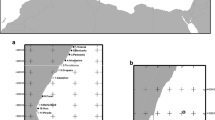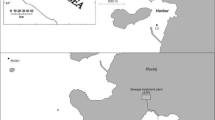Abstract
Future development in coastal areas of the southeastern United States (US) will likely result from urbanization (housing and tourist/service related activities) rather than industrialization. In an effort to identify potential impacts associated with urbanization, field studies were conducted in two small, high salinity estuaries of coastal South Carolina. The sites selected for study were Murrells Inlet, an estuary with a history of significant urbanization and North Inlet, a relatively pristine, undisturbed estuary. During field studies conducted in the fall of 1990, a series of 96-h in situ bioassays were undertaken at each of the sites. The species used were the grass shrimp, Palaemonetes pugio, and the mummichog, Fundulus heteroclitus. Water samples were collected at the site during these bioassays and analyzed for polyaromatic hydrocarbons (PAH) residues. Adult oysters, Crassostrea virginica, were also deployed at each of the sites during the in situ bioassays and analyzed for tissue PAH residues. Physicochemical water quality and rainfall were also monitored. Mean waterborne PAH levels were significantly higher at the urbanized Murrells Inlet site than at the more pristine North Inlet. Additionally, oysters deployed at the Murrells Inlet site showed increased PAH levels in comparison to baseline values while those deployed at the North Inlet had PAH levels well below baseline concentrations. No siterelated mortality was observed in the two species used in the bioassays. Fluctuations in salinity, dissolved oxygen, and pH were much less extreme at the urbanized Murrells Inlet site than at North Inlet. The less dynamic physicochemical environment at the Murrells Inlet site may be due in part to urban influences (i.e., jetty construction and bulkheading). Additional work is needed to better define the significance of these observations.
Similar content being viewed by others
References
Association of State and Interstate Water Pollution Control Administration (1985) America's Clean Water. The states nonpoint source assessment. Appendix ASIWPCA, Washington, DC
Bidleman TF, Castleberry AA, Foreman WT, Zaranski MT, Wall DW (1990a) Petroleum hydrocarbons in the surface water of two estuaries in the Southeastern United States. Est Coastal Shelf Sci 30:91–109
Bidleman TF, McConnell LL, Kucklick JR (1990b) Organic contaminants in Winyah Bay and North Inlet Estuaries: A preliminary investigation. Report to SC Sea Grant Consortium, Meeting Street, Charleston, SC, 48 pp
Buikema AL Jr., Niderlehner BR, Cairns J Jr. (1980) Use of grass shrimp in toxicity tests. In: AL Buikema Jr, J Carins Jr (eds) Aquatic invertebrate bioassays, PCN 04–715000–16. Am Society for Testing Materials, Philadelphia, 209 pp
Calder DR, Bearden CM, Boothe BB Jr (1976) Environmental inventory of a small neutral embayment: Murrells Inlet, South Carolina, Tech Rep No. 10. SC Wildlife and Marine Res Dept, Mar Res Center, Charleston, SC, 58 pp
Duda, AM (1982) Municipal point source and agricultural nonpoint source contributions to coastal eutrophication. Water Res 18:397–407
Eisler R (1987) Polycyclic aromatic hydrocarbons hazards to fish, wildlife, and invertebrates: a review. US Fish and Wildlife Service, Laurel, MD, Report #11, 82 pp
Environmental Protection Agency (1984) Nonpoint source pollution in the US; Report to Congress. US EPA, Office of Water Criteria and Standards Division; Washington, DC, 144 pp
— (1983) Nonpoint source runoff information EPA Report #430–9–83–009. US EPA, Office of Water, Washington, DC, 259 pp
— (1980) Water quality criteria documents, Vol 45 (231):79318–79379
Finley RJ (1975) Morphologic development and dynamic processes at a barrier island inlet, North Inlet, SC. Doctoral Dissertation, Dept Geology, Univ South Carolina, Columbia, SC, 272 pp
Fowler SW (1990) Critical review of selected heavy metals and chlorinated hydrocarbon concentrations in the marine environment. Mar Environ Res 29:1–64
Gruenhagen KS (1985) Physiological responses of the Eastern or American oyster, Crassostrea virginica, exposed to combined pollutants from a marina in a developed coastal estuary. Masters Thesis, School of Public Health, Univ South Carolina, Columbia, SC, 105 pp
Hamilton MA, Russo R, Thuston RV (1977) Trimmed Spearman-Karber method of estimating median lethal concentrations in toxicity bioassays. Environ Sci Technol 11:714–718
Hoffman EJ, Latimer SJ, Hunt CD, Mills GL, Quinn JG (1985) Storm runoff from highways. Water Air Soil Pollut 25:349–364
Hoffman EJ, Mills GL, Latimer JS, Quinn JG (1983) Annual inputs of petroleum hydrocarbons to the coastal environment via urban runoff. Can J Fish Aqua Sci 40:41–53
Hoffman EJ, Latimer JS, Mills GL, Quinn JG (1982) Petroleum hydrocarbons in urban runoff from a commercial land use area. J Water Pollut Control Fed 54:1517–1525
Horwitz W (1978) Good laboratory practices in analytical chemistry. Anal Chem 50:521–524
Humenik FJ, Smolen MD, Dressing SA (1987) Pollution from nonpoint sources. Where are we and where should we go? Environ Sci Technol 21:737–742
Krahn MM, Wigren CA, Pearce RW, Moore LE, Boger RG, Macleod WD Jr, Chan SL, Brown DW (1988) New HPLC cleanup and revised extraction procedures for organic contaminants. NOAA Tech Mem NMFS F/NWC-153:23–47, Washington, DC
Latimer JS, Mills GL, Hoffman EJ, Quinn JG (1986) Treatment of solids and petroleum hydrocarbons in stormwater runoff with an on-site detention basin. Bull Environ Contam Toxicol 36:548–555
Mathews TD, Stapor FW, Richter CR (1980) Ecological characterization of the sea island coastal region of SC and GA, Vol. I: Physical features of the characterization areas, FWS/OBS 79/40. US Fish and Wildlife Service, Office of Biological Services, Washington, DC, 212 pp
Moore D, Trent L (1971) Setting, growth and mortality of Crassostrea virginica in a natural marsh and a marsh altered by a housing development. Proc Natl Shellfish Assoc 61:51–58
National Academy of Sciences (1980) Petroleum in the marine environment. National Academy Press, Washington, DC, 107 pp
National Oceanic and Atmospheric Administration (1990) Earth is a marine habitat: habitat conservation program. US NOAA, National Marine Fisheries Service, Washington, DC, 8 pp
— (1988) Report to Congress research, October, 1986 through September, 1987. US NOAA, National Ocean Service, Washington, DC, 73 pp
-- (1984) Tide charts of North Washington, DC
Ngabe B, Scott GI, Bidleman TF (1991) Analysis of polycyclic aromatic hydrocarbons in urban runoff by fluorescence spectrometry and GC-MS, Abstract. American Chemical Society Annual Meeting, Marine Organic Chemistry Symposium, Atlanta, GA
Ouchi GI (1987) Control charting with Lotus 1–2–3. Am Lab 19:82–95
Scott GI (1979) The effects of seasonal chronic chlorination on the growth, survival and physiology of the American oyster, Crassostrea virginica (Gmelin). Dissertation, Marine Science Program, Univ South Carolina, Columbia, SC, 169 pp
Scott GI, Fulton M, Moore D, Chandler G, Key P, Hampton T, Marcus J, Jackson K, Baughman D, Trim A, Williams L, Louden C, Patterson E (1990) Agricultural insecticide runoff effects on estuarine organisms: Correlating laboratory and field toxicity testing with ecotoxicological biomonitoring. Report for US EPA, Gulf Breeze Laboratory, Gulf Breeze, FL, 497 pp
Scott GI, Ballou TG, Dahlin JA (1984) Summary and evaluation of the toxicological and physiological effects of pollutants on shellfish. Part two: Petroleum hydrocarbons. Final report prepared by Research Planning Institute, Columbia, SC. Submitted to US NOAA, Seattle, WA, 131 pp
South Carolina State Data Center (1991) Selected demographic data for South Carolina, Division of Research and Statistical Services, Columbia, SC
Sparks AK, Boswell JL, Mackin JG (1958) Studies on the comparative utilization of oxygen by living and dead oysters. Proc Natl Shellfish Assoc 48:92–102
Swearingen GR, Marcus JM (1983) A water quality assessment of marina activities at Murrells Inlet, Georgetown County, SC. South Carolina Depart of Health and Environ Control Report No. 027-83, 2600 Bull Street, Columbia, SC, 50 pp
Taylor JK (1985) Principles of quality assurance of chemical measurements. NBSIR 85-3105, pp 1–71
Turner LE (1978) The effects of intermittent low level chlorination upon the American oyster, Crassostrea virginica: A field study. Masters Thesis, School of Public Health, Univ of South Carolina, Columbia, SC, 67 pp
Wise SA, Brenner BA, Byrd GD, Chesler SN, Rebbert RE, Schantz MM (1988) Determination of polycyclic aromatic hydrocarbons in a coal tar standard reference material. Anal Chem 60:887–895
Author information
Authors and Affiliations
Rights and permissions
About this article
Cite this article
Fulton, M.H., Scott, G.I., Fortner, A. et al. The effects of urbanization on small high salinity estuaries of the southeastern United States. Arch. Environ. Contam. Toxicol. 25, 476–484 (1993). https://doi.org/10.1007/BF00214336
Received:
Revised:
Issue Date:
DOI: https://doi.org/10.1007/BF00214336




